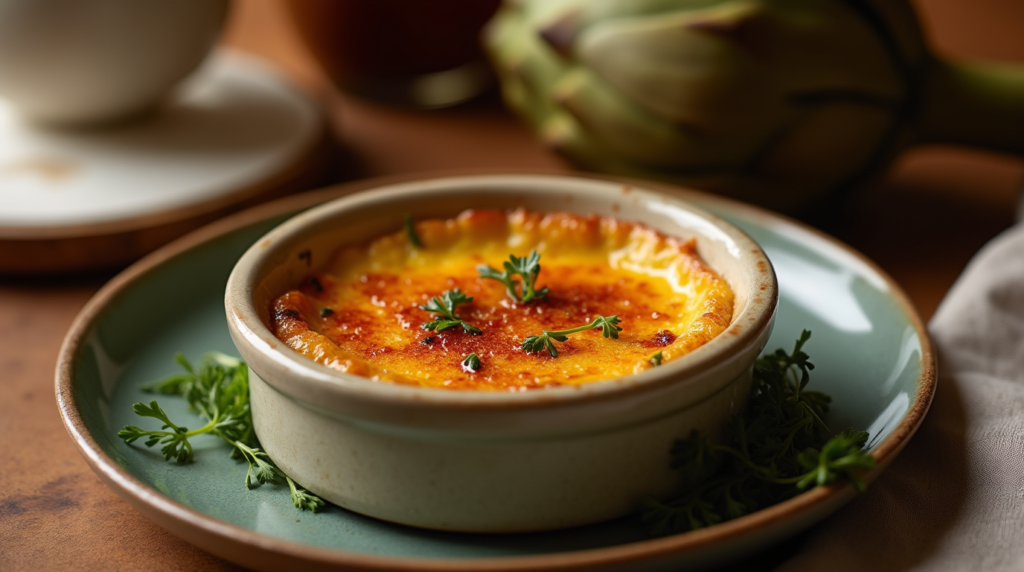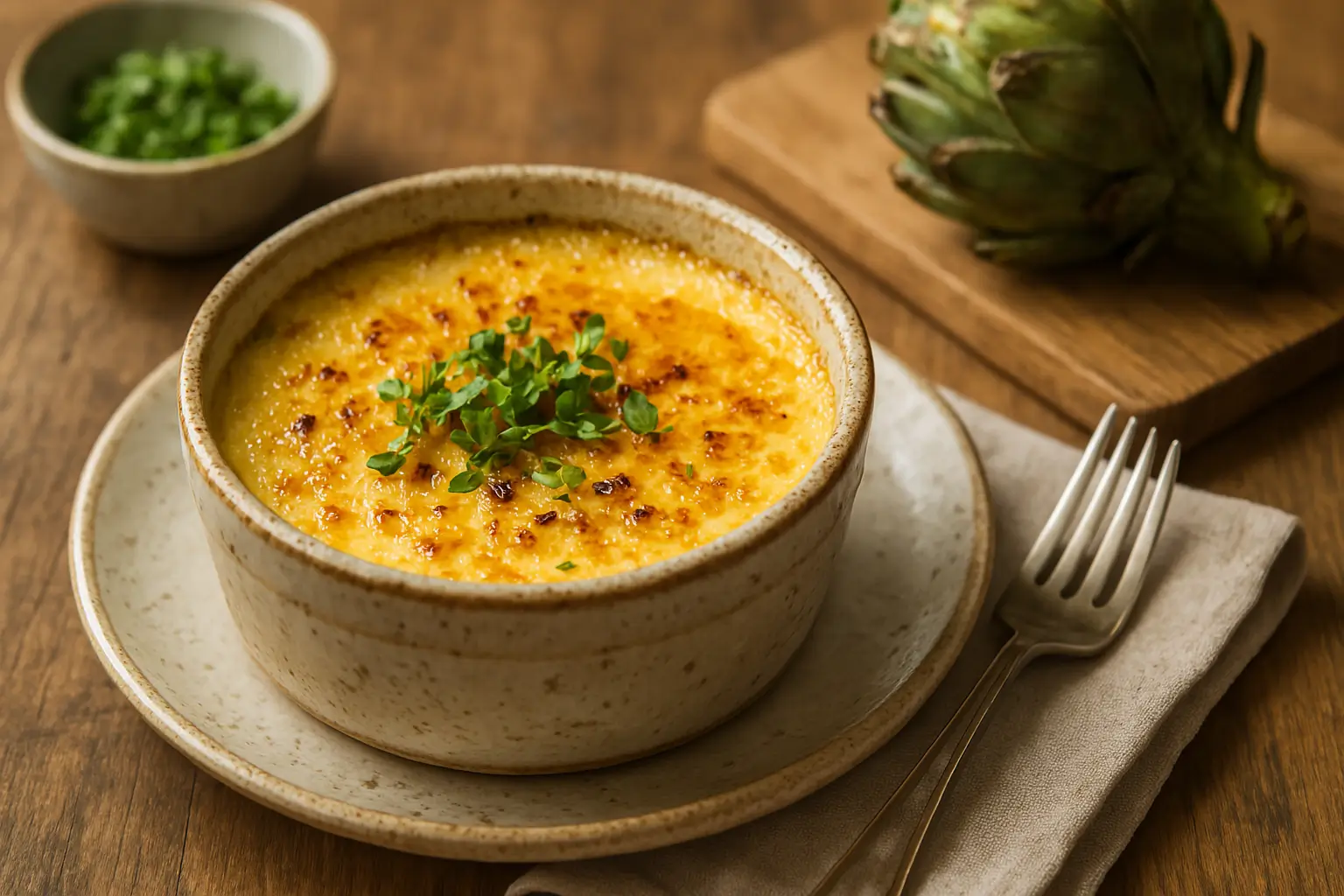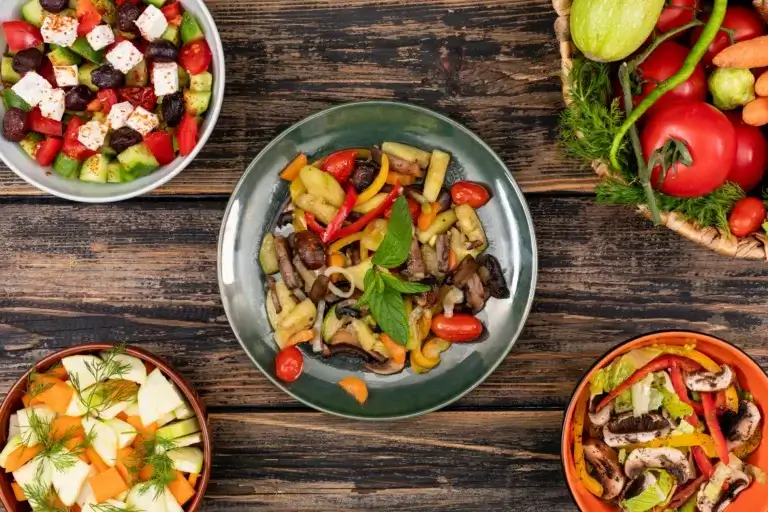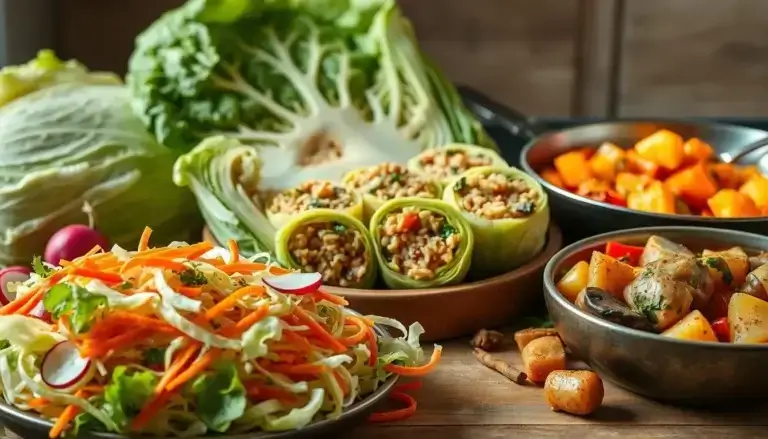Artichoke Brûlée: The Sophisticated Plant-Based Alternative to Seafood
Imagine breaking through a perfectly caramelized sugar crust to discover a velvety, savory custard studded with tender artichoke hearts that mimic the delicate texture of premium seafood. This innovative dish combines French culinary techniques with sustainable cooking principles to create something truly special for the plant-based enthusiast.
This sophisticated vegetarian creation transforms traditional French dessert methodology into a savory masterpiece that will impress even dedicated seafood lovers. Perfect for special gatherings or when you want to elevate your sustainable cooking repertoire to restaurant quality, this artichoke recipe delivers both elegance and satisfaction.
Table of Contents
Introduction to Plant-Based Gourmet Cooking
The culinary landscape has undergone a remarkable transformation in recent years, with plant-based cooking evolving far beyond simple vegetable dishes into sophisticated cuisine that rivals traditional favorites. This evolution represents a confluence of factors: environmental consciousness, health awareness, and genuine culinary innovation.
Gourmet plant-based cooking has emerged as an exciting frontier where chefs and home cooks alike experiment with techniques and ingredients to create dishes that satisfy on multiple levels. This isn’t merely about substitution—it’s about creating new classics that stand on their own merits.
The artichoke recipe we’re exploring exemplifies this approach. By borrowing the brûlée technique from French dessert tradition and applying it to a savory vegetarian context, we create something both familiar and entirely new. This marriage of classic technique with sustainable cooking principles perfectly represents the exciting direction of contemporary cuisine.
Why Artichokes Make Exceptional Seafood Alternatives
Artichokes possess several remarkable qualities that make them an ideal foundation for plant-based alternatives to seafood dishes:
- Texture Profile: When properly prepared, artichoke hearts develop a tender, flaky quality reminiscent of crabmeat or delicate white fish
- Flavor Adaptability: Their mild, subtly earthy taste readily absorbs other flavors while maintaining distinctive character
- Substantial Mouthfeel: Artichokes provide a satisfying density and bite that many vegetarian seafood substitutes lack
- Nutritional Complexity: They offer an impressive array of nutrients that parallel many seafood benefits
“Artichokes represent one of nature’s most versatile culinary chameleons,” notes the Sustainable Cooking Institute. “Their remarkable ability to transform through different preparations makes them invaluable in elevated plant-based cuisine.”
The environmental benefits of choosing artichoke recipes over seafood options also cannot be overstated. As marine ecosystems face unprecedented pressures, developing delicious plant-based alternatives to seafood classics supports both culinary innovation and ecological responsibility.
Essential Ingredients for Success
Creating an exceptional vegetarian seafood experience begins with carefully selected ingredients. Each component plays a specific role in developing the complex flavors and textures that make this dish memorable.
Foundation Ingredients
The base of our plant-based creation requires:
- 2 cans (14 oz each) artichoke hearts packed in water (not marinated varieties)
- Alternatively: 8-10 fresh artichoke hearts, properly cleaned and prepared
- 2 tablespoons fresh lemon juice to brighten flavors
- 1/4 teaspoon fine sea salt to enhance natural flavors
Ocean-Inspired Flavor Elements
To achieve a subtle maritime quality without using animal products:
- 1 teaspoon kelp powder or finely crushed nori sheets (provides mineral-rich ocean notes)
- 1 tablespoon vegetarian seafood seasoning blend (like Old Bay’s plant-based version)
- 1 teaspoon smoked paprika (adds complexity and subtle smoky depth)
- 3 tablespoons nutritional yeast (contributes savory umami character)
- 1 tablespoon white miso paste (optional, but enhances depth of flavor)
- 1/2 teaspoon capers, rinsed and finely chopped (provides briny accents)
Custard Components
For the luxurious, creamy base that supports the artichoke texture:
- 1 cup premium plant-based cream (oat cream provides exceptional results)
- 3 tablespoons chickpea flour or cornstarch as binding agents
- 1/4 cup silken tofu, thoroughly blended until completely smooth
- 1 tablespoon high-quality olive oil
- 1/2 teaspoon agar agar powder (ensures proper setting)
- 1/2 teaspoon kala namak (black salt) for subtle eggy notes
- 1/4 teaspoon white pepper for balanced seasoning
Brûlée Topping
For that signature caramelized crust:
- 2 tablespoons organic cane sugar
- 1 tablespoon turbinado sugar (adds depth to the caramelization)
Kitchen Equipment You’ll Need
Successful execution of this gourmet plant-based recipe requires several specific tools:
- 4 oven-safe ramekins (4-6 oz capacity each)
- Food processor or sharp knife for achieving proper artichoke texture
- Mixing bowls in various sizes
- Measuring spoons and cups for precision
- Baking dish large enough to create a water bath
- Kitchen torch for caramelizing the sugar topping
- Clean kitchen towel for removing excess moisture from artichokes
- Fine-mesh strainer for ensuring smooth custard texture
- Whisk for combining ingredients thoroughly
Complete Recipe Instructions
Yields: 4 servings Preparation Time: 25 minutes Cooking Time: 35 minutes Chilling Time: Minimum 1 hour
Preparation Phase for Artichoke Brûlée (25 minutes)
- Preheat your oven to 325°F (165°C) with a rack positioned in the center.
- Thoroughly drain the artichoke hearts, then pat dry with paper towels to remove surface moisture.
- Place the artichokes in a food processor and pulse 5-7 times until they achieve a texture similar to flaked crabmeat—you want recognizable pieces, not a puree.
- Transfer the processed artichokes to a clean kitchen towel and squeeze firmly to remove any remaining moisture—this critical step ensures proper texture in the final dish.
- In a blender, combine the plant cream, silken tofu, nutritional yeast, olive oil, chickpea flour, and agar agar powder. Blend on high until the mixture becomes completely smooth, about 1 minute.
- Transfer this mixture to a medium saucepan and cook over medium heat, whisking constantly to prevent scorching. Keep cooking until the mixture thickens significantly, which should take about 3-5 minutes. Remove from heat.
- Add the kelp powder, vegetarian seafood seasoning, smoked paprika, miso paste (if using), lemon juice, capers, kala namak, and white pepper to the cream mixture. Stir until thoroughly incorporated.
- Gently fold in the prepared artichoke hearts, taking care to maintain their texture while ensuring even distribution.
Baking Process (35 minutes)
- Divide the mixture evenly among four ramekins, filling each about 3/4 full.
- Place the ramekins in a deep baking dish. Create a water bath by carefully adding hot water to the baking dish until it reaches halfway up the sides of the ramekins.
- Loosely cover the entire baking dish with aluminum foil, leaving some space for steam to escape.
- Bake for 30-35 minutes. The custards are done when the edges appear set but the centers still have a slight jiggle when gently shaken.
- Carefully remove from the oven and allow to cool for 15 minutes before transferring to the refrigerator.
- Chill for at least 1 hour (or up to 24 hours) to allow the custards to set completely.
Creating the Perfect Brûlée Finish (5 minutes)
- Just before serving, combine the cane and turbinado sugars in a small bowl.
- Evenly sprinkle 1-2 teaspoons of the sugar mixture over each chilled custard to form a thin, uniform layer.
- Use a kitchen torch to carefully caramelize the sugar, holding the flame about 2 inches above the surface and moving in slow, circular motions.
- Continue until the sugar bubbles, melts, and transforms into a golden amber color.
- Allow the caramelized sugar to cool and harden for 2-3 minutes before serving.
Health and Nutritional Benefits
This sustainable cooking creation offers impressive nutritional advantages compared to traditional seafood dishes:
- Artichokes provide substantial fiber (7g per serving), vitamins C and K, folate, magnesium, and powerful antioxidants including cynarin and silymarin
- Plant-based creams deliver healthy fats without cholesterol or inflammatory compounds
- Nutritional yeast contributes B vitamins, including B12 in fortified versions
- Seaweed elements supply iodine, calcium, and trace minerals typically found in seafood
A single serving of this artichoke recipe contains approximately:
- Calories: 210
- Protein: 8g
- Fiber: 8g
- Fat: 13g (primarily unsaturated)
- Carbohydrates: 16g
- Sodium: 410mg
Professional Cooking Tips
Even experienced culinary enthusiasts can benefit from these insights when preparing this vegetarian seafood alternative:
Avoiding Common Pitfalls
- Moisture management: Inadequate drying of artichokes is the most common reason for texture problems—take time to thoroughly remove excess liquid
- Temperature control: Gentle heating prevents custard separation; watch carefully during stovetop thickening
- Patience is essential: Allow proper chilling time for the custards to set completely
Make-Ahead Strategies for Entertaining
This gourmet plant-based dish shines for entertaining because you can:
- Prepare the artichoke-cream mixture up to 48 hours in advance
- Bake the custards up to 24 hours before serving
- Add the caramelized sugar topping just minutes before presentation
Creative Flavor Variations
Experiment with these variations while keeping the core technique intact:
- Mediterranean: Incorporate sun-dried tomatoes, olives, and fresh basil
- Herbaceous: Add a tablespoon of finely chopped fresh herbs like dill, tarragon, and chervil
- Spicy: Include a touch of cayenne and minced preserved lemon
- Asian-inspired: Infuse with ginger, lemongrass, and a touch of coconut milk
Creative Serving Suggestions

Presentation elevates this plant-based alternative from merely delicious to truly memorable:
- Serve on a slate plate with a small nest of microgreens dressed in champagne vinaigrette
- Top with paper-thin slices of watermelon radish, arranged in an intricate pattern.
- Accompany with small triangles of artisan bread brushed with herb-infused olive oil
- Pair with premium kombucha, or sparkling mineral water with fresh herbs
Storage and Reheating Guidelines
If you have leftover Artichoke Brûlée (which is rare!), follow these guidelines:
- Cover each ramekin individually with biodegradable wrap and refrigerate for up to 3 days
- Avoid freezing, as this will compromise the delicate texture
- To reheat, place in a water bath in a 300°F (150°C) oven for 10 minutes
- Apply fresh sugar and torch before serving for the optimal experience
The Future of Sophisticated Plant-Based Cuisine
This artichoke recipe represents the exciting future of sustainable cooking—refined, flavorful, and capable of rivaling traditional favorites without compromise. By mastering techniques like this, home cooks participate in the evolution of plant-based cuisine that honors both culinary tradition and environmental responsibility.
Chefs worldwide are recognizing that vegetarian seafood alternatives need not be simple imitations but can instead become distinctive dishes in their own right. This philosophy of creating rather than merely substituting drives the most exciting developments in contemporary plant-based cooking.
Whether you’ve embraced plant-based eating for ethical, environmental, or health reasons—or simply enjoy culinary exploration—this dish offers a gateway to sophisticated
cooking that will impress even discerning palates.
FAQ about Artichoke Brûlée
Can I use marinated artichoke hearts instead of water-packed?
While technically possible, marinated artichokes bring additional flavors that will alter the delicate balance of the dish. For best results, use water-packed varieties and add your own seasonings.
What if I don’t own a kitchen torch?
Your oven’s broiler can work as an alternative. Place the sugar-topped custards on the highest rack position, watching carefully for 1-2 minutes until caramelized. The outcome may be a bit uneven, but it will still be delicious.
Is this recipe suitable for gluten-free diets?
Yes, as written, this recipe contains no gluten ingredients. Just verify your specific brands of seasonings and plant-based cream are certified gluten-free.
How can I make this recipe soy-free?
Replace the silken tofu and miso with an additional 1/4 cup of plant cream and 1 tablespoon of tahini. The texture will be slightly different but still excellent.
Can I prepare this without specialized ingredients like nutritional yeast or kala namak?
While these ingredients enhance the authentic flavor profile, you can create a simplified version. Focus on herbs, lemon, and quality olive oil for a different but still delicious interpretation of this artichoke-based dish.




